
Jaguar is the sports car and luxury vehicle brand of Jaguar Land Rover, a British multinational car manufacturer with its headquarters in Whitley, Coventry, England. Jaguar Cars was the company that was responsible for the production of Jaguar cars until its operations were fully merged with those of Land Rover to form Jaguar Land Rover on 1 January 2013.

The Jaguar XK is a two-door 2+2 grand tourer manufactured and marketed by Jaguar Cars from 1996–2012 and by Jaguar Land Rover from 2013–2014 in hatchback coupé and convertible body styles, across two generations. The XK was introduced at the Geneva Motor Show in March 1996 and was discontinued in July 2014.

The Jaguar E-Type, or the Jaguar XK-E for the North American market, is a British front mid-engined sports car that was manufactured by Jaguar Cars Ltd from 1961 to 1974. Its combination of exceptional aesthetics, advanced technologies, high performance, and competitive pricing established the model as an icon of the motoring world. The E-Type's claimed 150 miles per hour (240 km/h) top speed, sub-7-second 0 to 60 mph (97 km/h) acceleration, largely unitary body construction, front and rear independent suspension with disc brakes, mounted inboard at the rear, and rack-and-pinion steering, distinguished the car and spurred industry-wide changes.

The Jaguar XK150 is a sports car produced by Jaguar between 1957 and 1961 as the successor to the XK140.

The Aston Martin DB7 is a car that was produced by British luxury car manufacturer Aston Martin from September 1994 to December 2004. It was designed by Ian Callum and Keith Helfet as a grand tourer in coupé and convertible bodystyles. The prototype was complete by November 1992 and debuted at the Geneva Motor Show in March 1993. The six-cylinder DB7 was positioned as an "entry-level" model below the hand-built V8 Virage introduced a few years earlier. This model was the most-produced Aston Martin automobile up to that point in time, with more than 7,000 built before it was replaced by the DB9 in 2004.

Coventry Climax was a British forklift truck, fire pump, racing, and other speciality engine manufacturer.

The Jaguar XK is an inline 6-cylinder dual overhead camshaft (DOHC) engine produced by Jaguar Cars between 1949 and 1992. Introduced as a 3.4-litre, it earned fame on both the road and track, being produced in five displacements between 2.4 and 4.2-litres for Jaguar passenger cars, with other sizes being made by Jaguar and privateers for racing. A de-rated version was also used in certain military vehicles built by Alvis and Daimler.

An evolution of the 1964 DOHC prototype “XJ13” engine, the Jaguar V12 engine is a family of SOHC internal combustion V12 engines with a common block design, that were mass-produced by Jaguar Cars for a quarter of a century, from 1971 to 1997, mostly as 5.3‑litres, but later also as 6‑litres, and 7‑litre versions that were deployed in racing. Except for a few low-volume exotic sports car makers, Jaguar's V12 engine was the world's first V12 engine in mass-production. For 17 years, Jaguar was the only company in the world consistently producing luxury four-door saloons with a V12 engine. The V12 powered all three series of the original Jaguar XJ luxury saloons, as well as its second generation XJ40 and X305 successors.

In automotive engineering a multi-valve or multivalve engine is one where each cylinder has more than two valves. A multi-valve engine has better breathing and may be able to operate at higher revolutions per minute (RPM) than a two-valve engine, delivering more power.
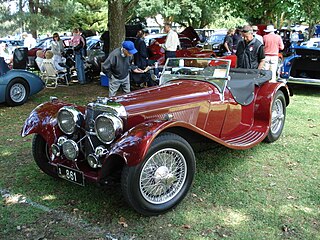
The SS Jaguar 100 is a British 2-seat sports car built between 1936 and 1939 by SS Cars Ltd of Coventry, England. The manufacturer's name 'SS Cars' used from 1934 maintained a link to the previous owner, Swallow Sidecar, founded in 1922 by Walmsley and Lyons to build motorcycle sidecars. In March 1945 the S. S. Cars shareholders agreed to change the name to Jaguar Cars Limited.

The BMC C-Series is a straight-6 automobile engine produced from 1954 to 1971. Unlike the Austin-designed A-Series and B-Series engines, it came from the Morris Engines drawing office in Coventry and therefore differed significantly in its layout and design from the two other designs which were closely related. This was due to the C-Series being in essence an enlarged overhead valve development of the earlier 2.2 L Straight-6 overhead camshaft engine used in the post-war Morris Six MS and Wolseley 6/80 from 1948 until 1954, which itself also formed the basis of a related 1.5 L 4-cylinder engine for the Morris Oxford MO in side-valve form and the Wolseley 4/50 in overhead camshaft form. Displacement was 2.6 to 2.9 L with an undersquare stroke of 88.9 mm (3.50 in), bored out to increase capacity.

The Jaguar Mark IX is a four-door luxury saloon car announced 8 October 1958 and produced by Jaguar Cars between 1958 and 1961. It was generally similar to the Mark VIII it replaced, but had a larger, more powerful 3.8 litre engine, 4-wheel disc brakes, and power assisted recirculating ball steering among its mechanical improvements.

The Jaguar Mark 2 is a mid-sized luxury sports saloon built from late 1959 to 1967 by Jaguar in Coventry, England. The previous Jaguar 2.4 Litre and 3.4 Litre models made between 1955 and 1959 are identified as Mark 1 Jaguars.
Weslake & Co also known as Weslake Research and Development was founded by Harry Weslake, described as England's greatest expert on cylinder head design, with premises in Rye, East Sussex, England. Weslake is most famous for its work with Bentley, Austin, Jaguar and the Gulf-Wyer Ford GT40 Mk.I.
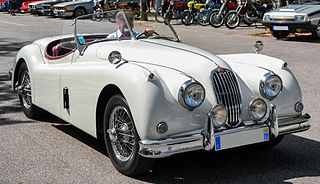
The Jaguar XK140 is a sports car manufactured by Jaguar between 1954 and 1957 as the successor to the XK120. Upgrades included more interior space, improved brakes, rack and pinion steering, increased suspension travel, and telescopic shock absorbers instead of the older lever arm design.
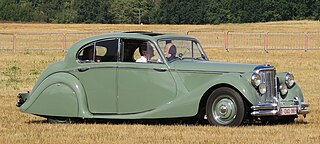
The Jaguar Mark V is a luxury automobile built by Jaguar Cars Ltd of Coventry in England from 1948 to 1951. It was available as a four-door Saloon (sedan) and a two-door convertible known as the Drop Head Coupé, both versions seating five adults. It was the first Jaguar with independent front suspension, first with hydraulic brakes, first with spats, first specifically designed to be produced in both Right and Left Hand Drive configurations, first with disc centre wheels, first with smaller wider 16" balloon tyres, first to be offered with sealed headlamps and flashing turn signals for the important American market, and the last model to use the pushrod engines.
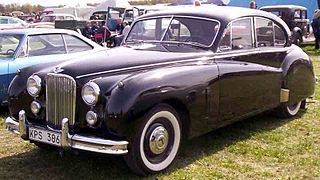
The Jaguar Mark VII is a four-door luxury car produced by Jaguar Cars of Coventry from 1951 to 1956. Launched at the 1950 British International Motor Show as the successor to the Jaguar Mark V, it was called the Mark VII because there was already a Bentley Mark VI on the market. A version of the Jaguar Mark V with the XK engine had been designated as the Mark VI, but it is thought that only two were built.
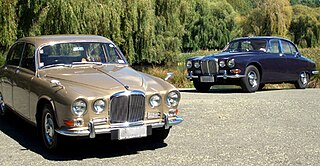
The Jaguar 420 and its Daimler Sovereign equivalent were introduced at the October 1966 London Motor Show and produced for two years as the ultimate expression of a series of "compact sporting saloons" offered by Jaguar throughout that decade, all of which shared the same wheelbase. Developed from the Jaguar S-Type, the 420 cost around £200 more than that model and effectively ended buyer interest in it, although the S-Type continued to be sold alongside the 420/Sovereign until both were supplanted by the Jaguar XJ6 late in 1968.

The Jaguar XK is the second and final generation of the Jaguar XK 2+2 grand tourer manufactured and marketed by British automobile manufacturer Jaguar Cars under the X150 internal designation. The three-door fastback coupé debuted at the 2005 Frankfurt Motor Show with the 4.2-litre V8 engine of its predecessor, and the two-door convertible debuted in 2006 at the North American International Auto Show.
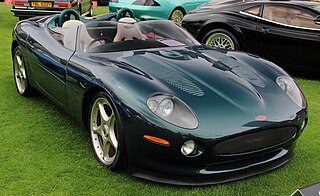
The Jaguar XK 180 is a concept car created by the British car manufacturer Jaguar Cars to celebrate the 50th anniversary of the XK car and to show the world the skills of Jaguar stylists, craftsmen and engineers. It was presented at the Paris Motor Show in 1998.




















